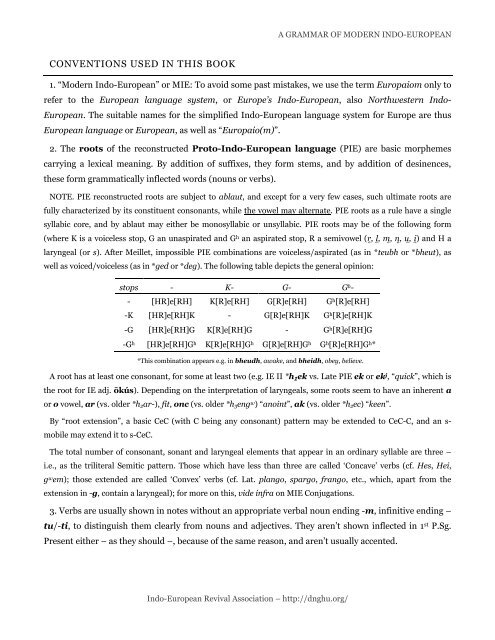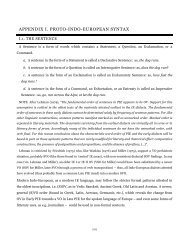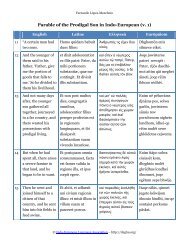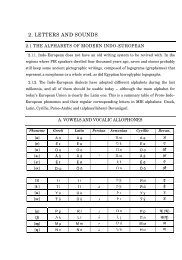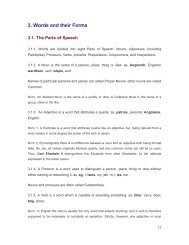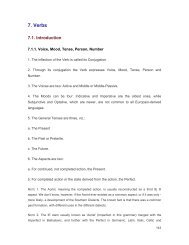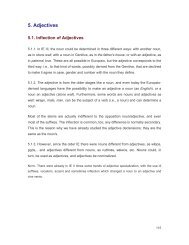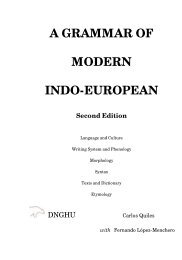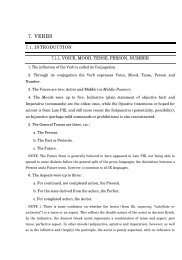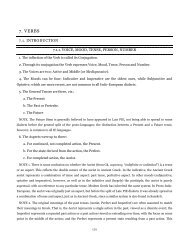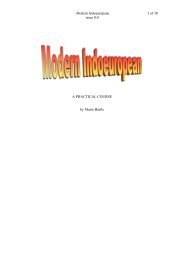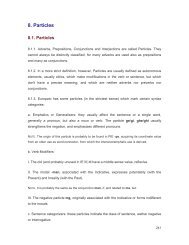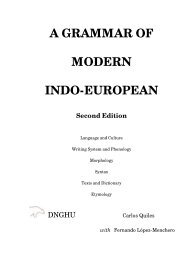You also want an ePaper? Increase the reach of your titles
YUMPU automatically turns print PDFs into web optimized ePapers that Google loves.
CONVENTIONS USED IN THIS BOOK<br />
Indo-European Revival Association – http://dnghu.org/<br />
A <strong>GRAMMAR</strong> <strong>OF</strong> <strong>MODERN</strong> <strong>INDO</strong>-<strong>EUROPEAN</strong><br />
1. ―Modern Indo-European‖ or MIE: To avoid some past mistakes, we use the term Europaiom only to<br />
refer to the European language system, or Europe‟s Indo-European, also Northwestern Indo-<br />
European. The suitable names for the simplified Indo-European language system for Europe are thus<br />
European language or European, as well as ―Europaio(m)‖.<br />
2. The roots of the reconstructed Proto-Indo-European language (PIE) are basic morphemes<br />
carrying a lexical meaning. By addition of suffixes, they form stems, and by addition of desinences,<br />
these form grammatically inflected words (nouns or verbs).<br />
NOTE. PIE reconstructed roots are subject to ablaut, and except for a very few cases, such ultimate roots are<br />
fully characterized by its constituent consonants, while the vowel may alternate. PIE roots as a rule have a single<br />
syllabic core, and by ablaut may either be monosyllabic or unsyllabic. PIE roots may be of the following form<br />
(where K is a voiceless stop, G an unaspirated and G h an aspirated stop, R a semivowel (r̥, l̥, m̥, n̥, u̯, i̯) and H a<br />
laryngeal (or s). After Meillet, impossible PIE combinations are voiceless/aspirated (as in *teubh or *bheut), as<br />
well as voiced/voiceless (as in *ged or *deg). The following table depicts the general opinion:<br />
stops - K- G- G h -<br />
- [HR]e[RH] K[R]e[RH] G[R]e[RH] G h [R]e[RH]<br />
-K [HR]e[RH]K - G[R]e[RH]K G h [R]e[RH]K<br />
-G [HR]e[RH]G K[R]e[RH]G - G h [R]e[RH]G<br />
-G h [HR]e[RH]G h K[R]e[RH]G h G[R]e[RH]G h G h [R]e[RH]G h *<br />
*This combination appears e.g. in bheudh, awake, and bheidh, obey, believe.<br />
A root has at least one consonant, for some at least two (e.g. IE II *h₁ek vs. Late PIE ek or ek j , ―quick‖, which is<br />
the root for IE adj. ōkús). Depending on the interpretation of laryngeals, some roots seem to have an inherent a<br />
or o vowel, ar (vs. older *h2ar-), fit, onc (vs. older *h3eng w ) ―anoint‖, ak (vs. older *h2ec) ―keen‖.<br />
By ―root extension‖, a basic CeC (with C being any consonant) pattern may be extended to CeC-C, and an s-<br />
mobile may extend it to s-CeC.<br />
The total number of consonant, sonant and laryngeal elements that appear in an ordinary syllable are three –<br />
i.e., as the triliteral Semitic pattern. Those which have less than three are called ‗Concave‘ verbs (cf. Hes, Hei,<br />
g w em); those extended are called ‗Convex‘ verbs (cf. Lat. plango, spargo, frango, etc., which, apart from the<br />
extension in -g, contain a laryngeal); for more on this, vide infra on MIE Conjugations.<br />
3. Verbs are usually shown in notes without an appropriate verbal noun ending -m, infinitive ending –<br />
tu/-ti, to distinguish them clearly from nouns and adjectives. They aren‘t shown inflected in 1 st P.Sg.<br />
Present either – as they should –, because of the same reason, and aren‘t usually accented.


